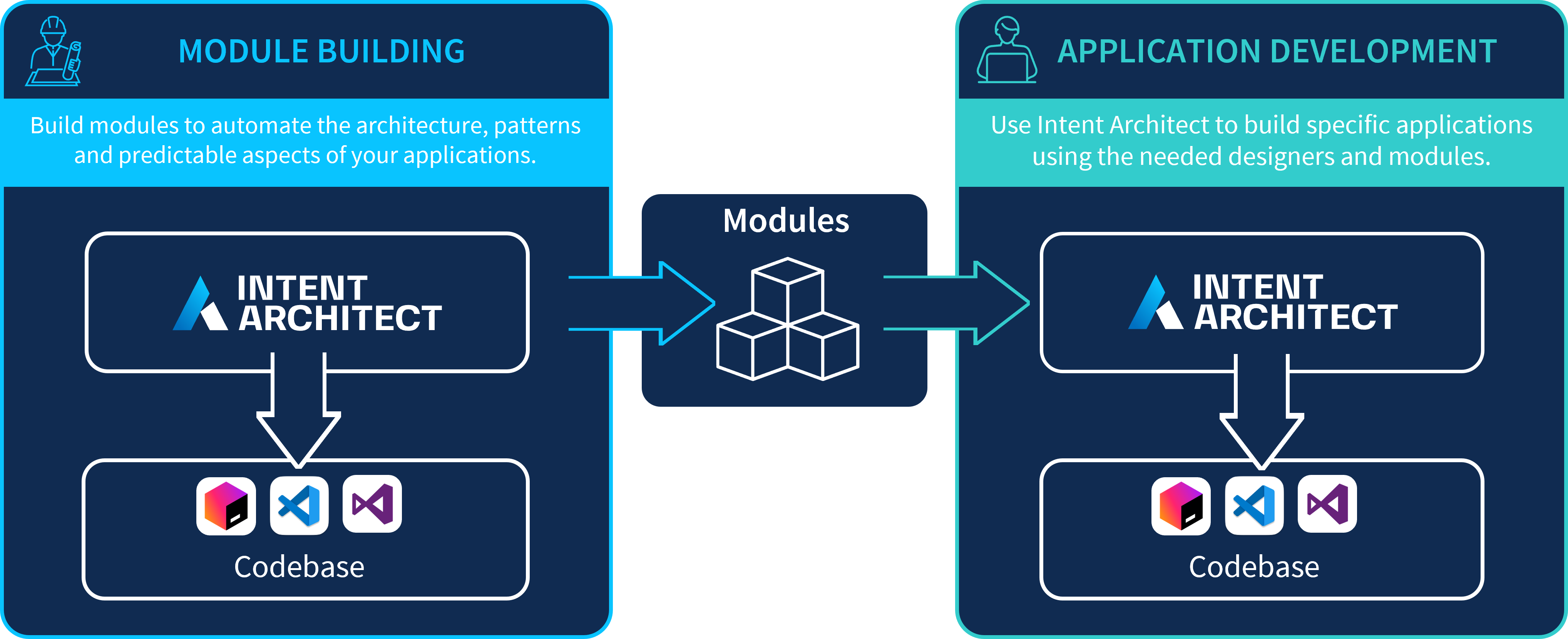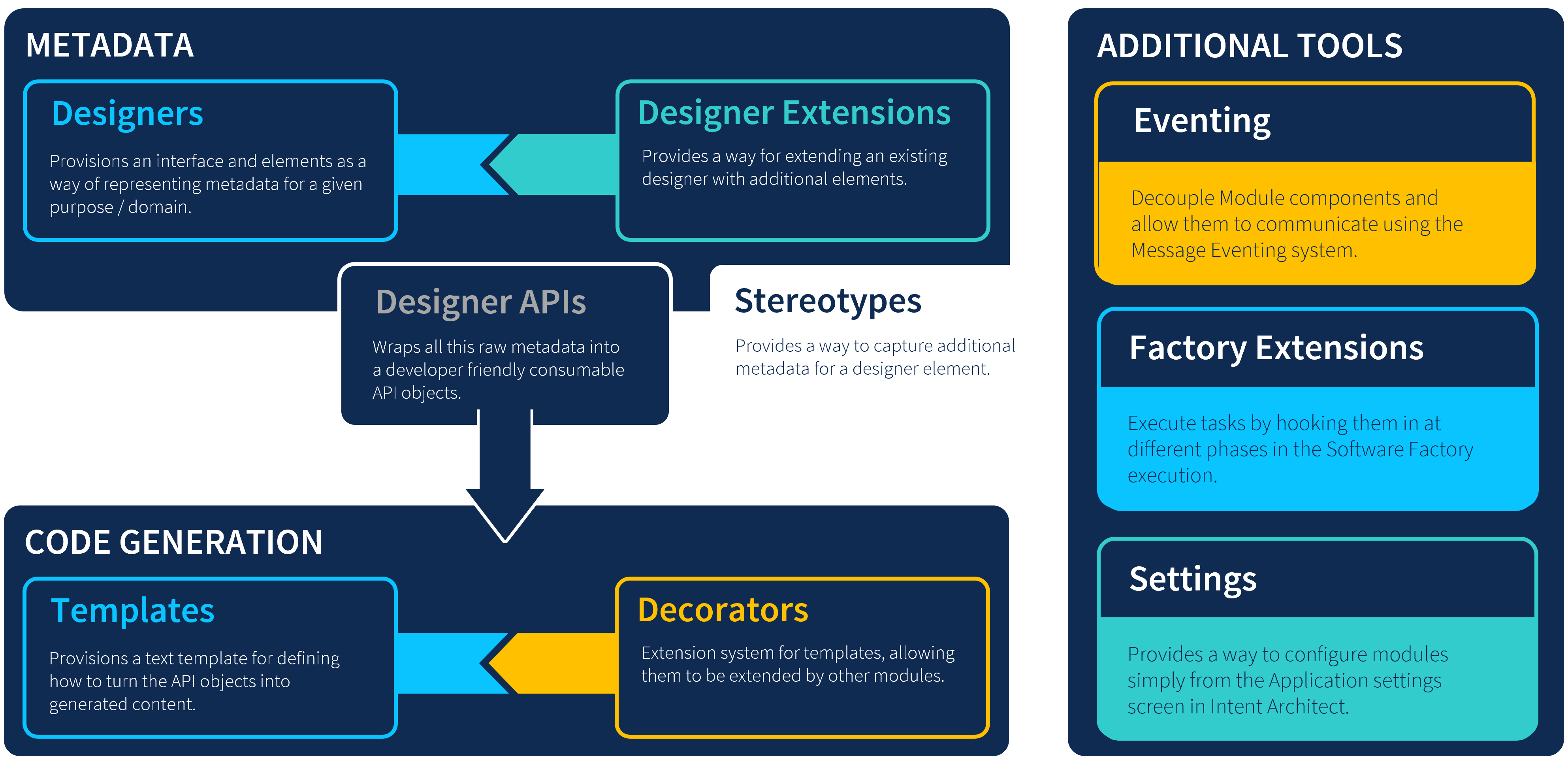Overview
For an introduction to module building watch the recording of our Introduction to Module Building Webinar.
The Two Development Roles
In the same way that traditional software development teams have members who fulfil different roles (such as developing infrastructure, architecture, backends, front-end applications, API integration and consumer services, etc.) Intent Architect is no different in that developers who design and implement Applications may be different to the developers who supply the Modules that support the ability for the Application developers to function (more efficiently) and deliver value.

Note
Not all software development teams may have the need to develop and maintain their own Modules, since Intent Architect offers a suite of Modules out of the box to development teams. However, Intent Architect offers power and flexibility for those who do.
Module Building
This can be likened in general to developers who create their own library packages for Nuget, NPM, Yarn, PIP, etc. It allows for an installable package to supply code that can plug in to the existing code-base to provide additional functionality to help achieve the goal of delivering business value.
Developers who build Modules in Intent Architect are providing different value in that their focus is on finding ways to automate architecture, patterns and any other predictable aspects of software development and provide installable Module packages to the development teams who need them.
This can form part of the same software development development-cycle of the team who is developing applications using Intent Architect, or it can even be an entirely different team operating on a separate development-cycle.
Application Development
These are the consumers of the said Module packages who install and benefit from the automation features that it provides. This can include new forms of code being generated which saves a lot of time and effort for development teams or it can be that new and/or enhanced designers are provided which offer richer designing experiences and can potentially offer opportunities for other parts of the code-base to be automated that previously had to be maintained by hand.
Module Building Ecosystem
Ecosystem

The module building ecosystem comprises of one or more of the following aspects:
Metadata
Metadata is the term used to describe all information that can be captured with Intent Architect designers. The Software Factory during its execution makes metadata available to modules which then use it to determine what code to generate.
Designers
Designers are the visual modellers in an Intent Architect application which allow users to capture and compose metadata. Designers are highly configurable so that they can be tailored to capture information in a way that is intuitive and natural for the particular project or application.
Designer Extensions
Intent Architect supports extending designers. Designer extensions allow adding additional element types and behaviour to an existing designer, providing the following powerful benefits:
- No need to copy an entire existing designer when you want to make a single small addition to it.
- Multiple designer extensions extending a single designer can be installed at the same time and they all continue working as expected.
- One can generally upgrade the module with the base designer to take advantage of new designer features with the designer extensions not needing to be updated to continue working.
Stereotypes
Stereotypes allow "decoration" of elements and are analogous to decoration features in programming languages, such as C# Attributes or Java Annotations. Common use of Stereotypes is specifying technology or business domain specific metadata for Elements in the Intent Architect designer, such as a Class having a business requirement of being audited, or a Service Operation's HTTP method.
Note
In comparison to designers and designer extensions, stereotypes allow adding additional "fields" or values to a particular element, while designers and designer extensions are for defining additional element types and element behaviours (such as context menu options, where they can be used, etc).
Designer APIs
Not only do users of Intent Architect have an interface with which to model what the metadata should look like, Module developers will also get an easy to use generated API to query the modelled metadata for Template development, see for example.
Code Generation
Code generation is the process of running the Software Factory which provides metadata from the designers to installed modules which use it to generate output (normally code).
Templates
Templates are responsible for generating the actual content of output files, the Software Factory runs each template for each installed module in turn to ultimately generate the output of all the different files. The vast majority of module building is the authoring of templates.
For more information on authoring templates, see the tutorial.
Decorators
Decorators are a mechanism which can be used by Templates in order to inject content at certain hook points within a Template. Templates expose a Decorator contract which can be implemented by Decorators in different modules. In this way Templates can be extended by modules on which they have no dependency and might have been created by completely different authors or even companies.
Additional Tools
More module building features for advanced use cases or requirements.
Module Settings
Adds a new section on the Application Settings view to allow end-users to configure how your module should work by adjusting settings that your module exposed.
For example a module has a setting that allows the user to choose which primitive type to use when generating Primary Key columns for SQL tables that can either be int, bigint or uniqueidentifier.
Eventing
A fully decoupled mechanism for modules to interact with each other through use of messages and the event dispatcher within the Software Factory, commonly used for fulfilling architectural infrastructural concerns.
For example a template may need a registration to be performed with a system's dependency injection framework, without the template being aware of what dependency injection framework will ultimately be used. The template would simply publish a message saying what it needs, then multiple different modules (for example, AutoFac or Ninject modules) would be configured to listen to these messages and fulfil them making it so that regardless of which module is installed, everything still works.
Factory Extensions
Factory Extensions are used to hook into and extend any of the pre-defined phases of the Software Factory process, use cases where this is useful include:
- Loading Metadata from outside Intent Architect.
- Alter the output produced from Templates.
- Execute external processes which developers might have needed to execute manually after a Software Factory Execution.